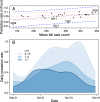Killer whales redistribute white shark foraging pressure on seals
- PMID: 30992478
- PMCID: PMC6467992
- DOI: 10.1038/s41598-019-39356-2
Killer whales redistribute white shark foraging pressure on seals
Abstract
Predatory behavior and top-down effects in marine ecosystems are well-described, however, intraguild interactions among co-occurring marine top predators remain less understood, but can have far reaching ecological implications. Killer whales and white sharks are prominent upper trophic level predators with highly-overlapping niches, yet their ecological interactions and subsequent effects have remained obscure. Using long-term electronic tagging and survey data we reveal rare and cryptic interactions between these predators at a shared foraging site, Southeast Farallon Island (SEFI). In multiple instances, brief visits from killer whales displaced white sharks from SEFI, disrupting shark feeding behavior for extended periods at this aggregation site. As a result, annual predations of pinnipeds by white sharks at SEFI were negatively correlated with close encounters with killer whales. Tagged white sharks relocated to other aggregation sites, creating detectable increases in white shark density at Ano Nuevo Island. This work highlights the importance of risk effects and intraguild relationships among top ocean predators and the value of long-term data sets revealing these consequential, albeit infrequent, ecological interactions.
Conflict of interest statement
The authors declare no competing interests.
Figures



References
-
- Williams TM, Estes JA, Doak DF, Springer AM. Killer Appetites: Assessing the Role of Predators in Ecological Communities. Ecology. 2004;85:3373–3384. doi: 10.1890/03-0696. - DOI
Publication types
MeSH terms
LinkOut - more resources
Full Text Sources
Research Materials

